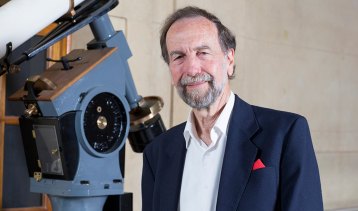Astronomer had planet ‘171429 Hunstead’ named in his honour – Brisbane Times
For six decades, Professor Richard Waller Hunstead was part of the University of Sydney. He arrived as a first-year student in 1960 and went on to become one of astronomy’s most distinguished scientists.

Astronomer Dick Hunstead
He leaves an influential legacy for many areas of astronomy – optical, radio and X-rays. Following a BSc (Hons) and PhD at the University of Sydney, he became one of the School of Physics most admired teachers and researchers.
Dick Waller Hunstead was born in Sydney in 1943 and attended North Sydney Boys High School, where he was an excellent scholar and a gifted musician. His interest in music continued throughout his life but his career was in science, specifically physics. He was also a passionate and skilled photographer, particularly of birds, flowers and insects.
As a quiet undergraduate at Sydney University, his encounters with the legendary cigar-smoking Harry Messel might have been daunting, but Dick’s interest in physics and astronomy led him to initiate a new approach to the teaching of experimental physics – particularly in the field of electronics – all while he was a part-time PhD student and a tutor.
This passion for teaching and mentoring students continued all his career. Even when enormously busy leading major research projects, Dick found time to carefully update and co-ordinate student laboratory notes across all undergraduate years.
A quote from an Oral History taken in 2005 says it all: “I don’t place a lot on the research that I’ve done, although I’ve enjoyed it. It’s all been great fun. I get the biggest buzz from working with students and seeing them develop into researchers through to their PhDs and beyond.”
However, his research has been incredibly important. As a PhD student, his supervisor was the pioneer radio astronomer Professor Bernard Mills, and Hunstead was part of the team building the Molonglo Cross – a radio telescope located in the Molonglo Valley, about 30km east of Canberra – that produced exceptional maps of the sky at a frequency of 408 MHz.
As well as helping with the actual construction, his principal task was to calibrate the positional accuracy of the instrument, which no one knew how to do. The solution was to cross-match the radio sources with their counterparts at visible wavelengths.
Over many weeks, Hunstead observed the sky at 408 MHz and then set about measuring the positions of optical counterparts using a machine that measured accurately using a microscope objects on plates taken with the Palomar Telescope. His work was essential to the operation and international acceptance of the output from the telescope.
As a researcher, he made many seminal discoveries. The first important one was that some radio sources varied on short time scales. This was disputed for some years. However, he was a careful and meticulous observer and through his persistence, this variability was eventually recognised as indicative of very small objects scintillating as the radiation passed through the intervening intergalactic medium.

Astronomer Dick Hunstead
Hunstead was fascinated with quasars, the immensely bright and distant objects that he had used in his calibration work. He went on to make major discoveries on the nature of these objects, linking them to distant galaxies with supermassive black holes at their centres.
In research, he gained an international reputation based on work over many decades and published in nearly 200 refereed papers. His discoveries include seminal work on quasars and radio galaxies, especially giant radio galaxies, and ground-breaking studies on the spectral properties of quasars.
Most recently, he had returned to his love of the variable sky and has been part of a project at Molonglo to detect the mysterious bright sparkler sources called Fast Radio Bursts. His fascination with astronomy was eclectic and broad-ranging, including studying many areas from the gigantic black holes in distant galaxies to the impact of Shoemaker Levy comet as it crashed into Jupiter in 1994.
The significance of his research was recognised with an ISI Web of Science Citation Laureate award for the impact of his publications in the period 1981 to 1998. His influence and broad contribution to astronomy are recognised by the naming of a minor planet in his honour, 171429 Hunstead.
As well as being an excellent collaborator and researcher, he was a wonderful supervisor. He has been the supervisor and mentor of an extraordinary number of staff and honours, PhD and undergraduate students. He was a gentle critic who used green pen as a corrector as he felt covering a script with red pen was too confronting.
Loading
Hunstead taught in lectures and laboratories at every level. His particular passion for experimental physics saw him make invaluable contributions to the design and constructions of numerous experiments, with outcomes that have greatly enhanced the student experience.
From 1998 to 2012, he was coordinator for the Talented Student Program, an initiative that introduces top academic students to scientific research from their first year. He also held several leadership roles in the School of Physics, and has been Director of the Molonglo Radio Observatory for more than a decade.
Dick Hunstead showed his passion and dedication to the field of Astronomy and the School of Physics with a an extraordinarily generous gift, with his wife Penny, to support ongoing research and education activities in the University’s Sydney Institute for Astronomy.
He passed away on January 30, following a sudden illness, aged 76 years. He is survived by his wife of 54 years, Penny, daughter Anna, and grandson, Patrick, as well as his siblings Camilla, Michael and Juliet.
Anne Green, Emeritus Professor of Astrophysics.
Richard Waller Hunstead: May 30, 1943 – January 30, 2020.
Loading





